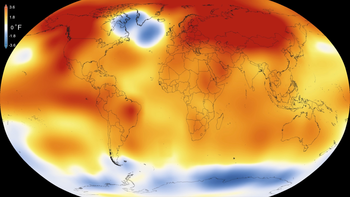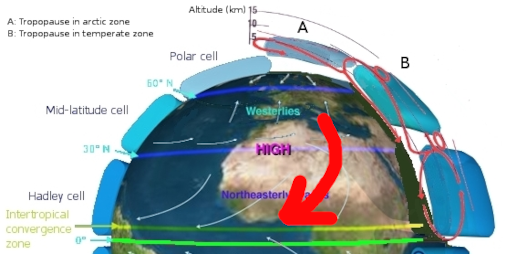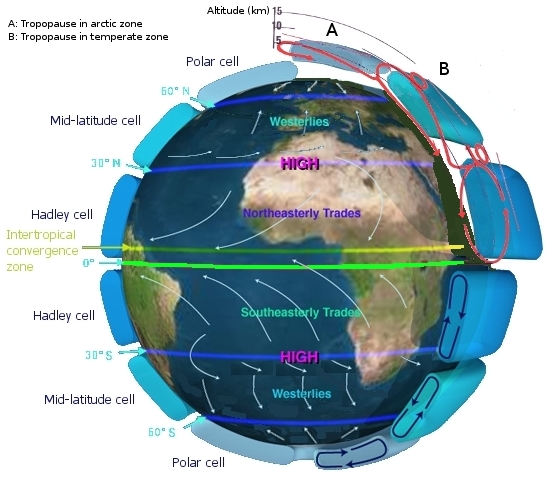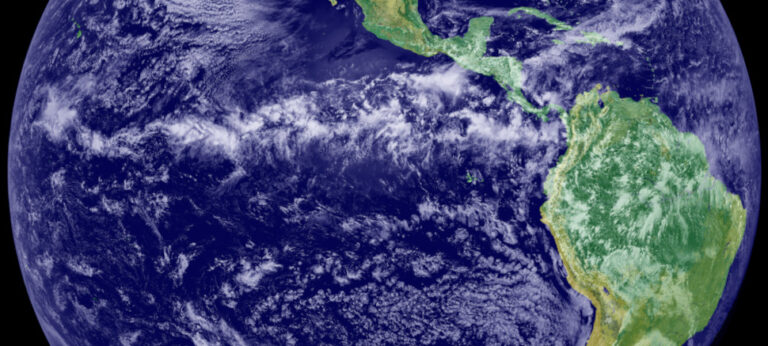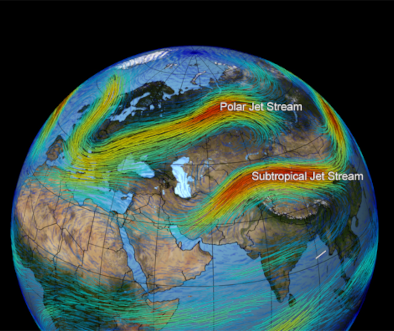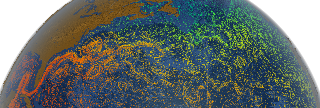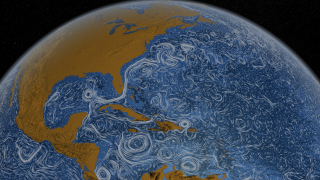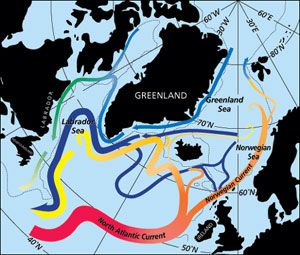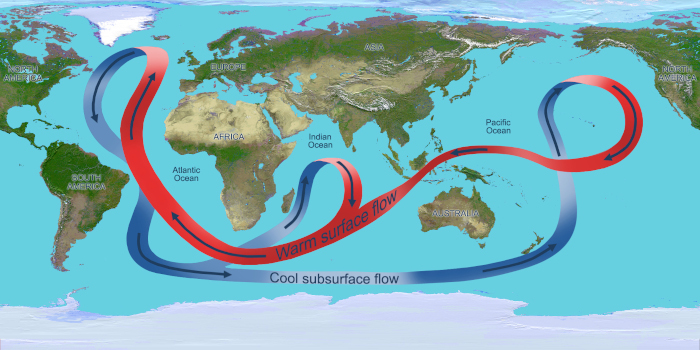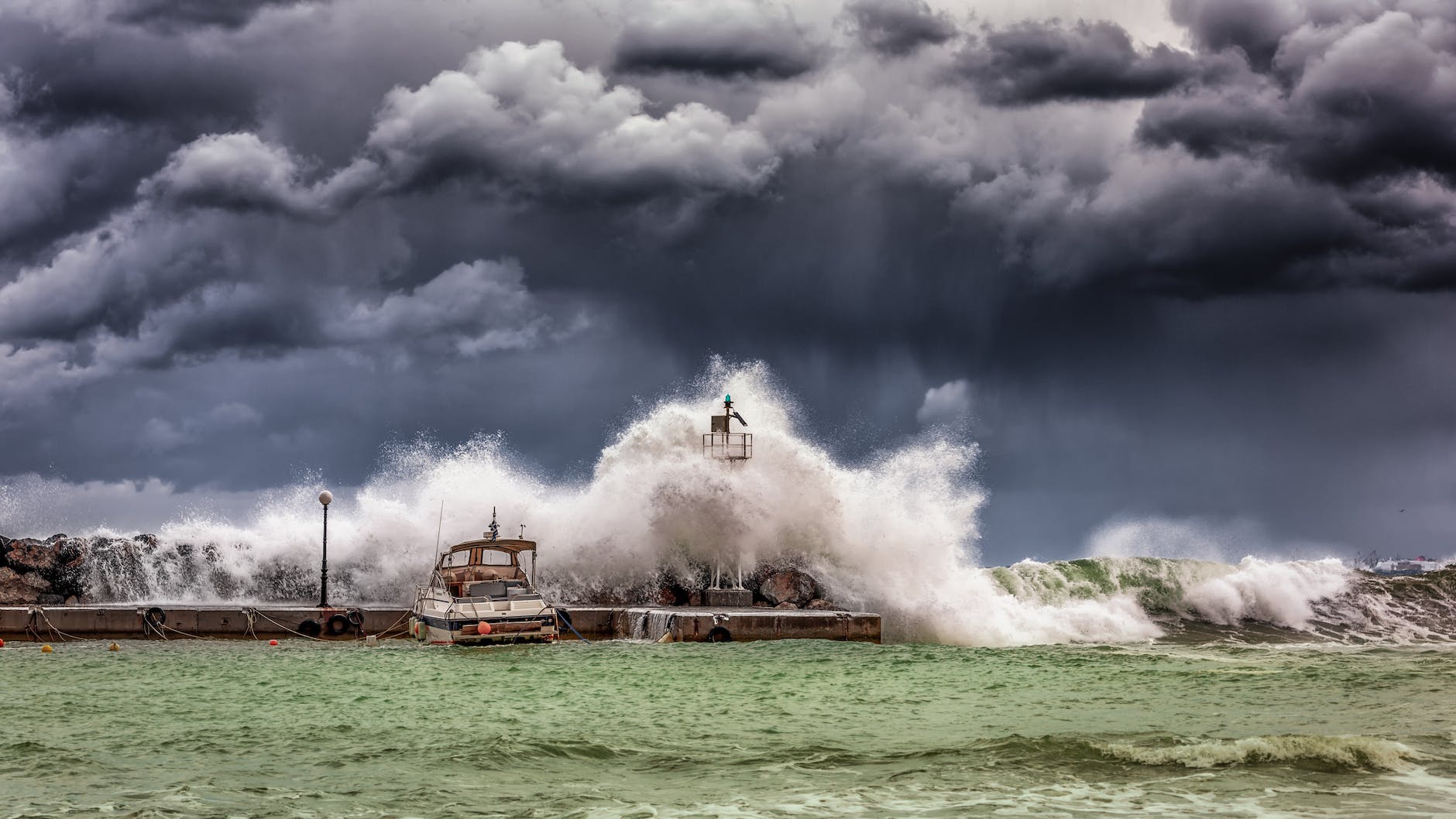

Global climate change
The impact of global warming on our wind and ocean currents is under intensive investigation. While we are still piecing together the full puzzle of how these systems will respond, it is beyond doubt that shifts in these currents are unfolding simultaneously with our warming world.
Wind and climate change
Climate change is influencing the rhythm of our seasons and the character of local climates. Some regions might embrace a more tropical essence, while others, like arid deserts, may become even more inhospitable due to escalated heat. In certain corners of the globe, desertification is taking hold, and instances of extreme temperatures and natural disasters are growing more frequent.
The behavior of phenomena such as El Niño within the framework of global warming remains an ongoing subject of study, and there’s a concern among scientists that the potentially destructive nature of El Niño Southern Oscillation (ENSO) could become more pronounced as global temperatures continue to rise.
Scientific insights, including those from the Intergovernmental Panel on Climate Change (IPCC), suggest a potential weakening of global wind currents by around 10% by the year 2100 due to the influence of global warming. The Northern Hemisphere is experiencing more pronounced warming, due to its larger landmass in contrast to the Southern Hemisphere, which is dominated by expansive oceans. Land tends to warm more quickly than ocean waters when exposed to solar energy. This could make this hemisphere an early detector of climate pattern shifts.
Over the past couple of decades, there appears to have been an observable uptick in tropical storm activity across the Atlantic Ocean, the Caribbean, and the Gulf of Mexico. Moreover, there are indications that the Gulf Stream, known for reliably transporting warm and mild climates to Europe, is encountering challenges. Additionally, it seems that the polar jet streams in the Northern Hemisphere might be experiencing more frequent periods of weakening. This potential weakening could lead to the intrusion of cold air from the North Pole over parts of Europe. Furthermore, it’s suggested that these seemingly more relaxed jet streams could be playing a role in potentially accelerating ice loss in the North Pole region.
The wind carries not just air but stories of heat, moisture, and even pollutants. This movement deeply influences ecosystems and biodiversity, underscoring its role as a prime conductor of life on our planet. Perturbations in these wind harmonies can ripple through the fabric of nature, affecting the growth of plants, the vitality of habitats for animals and humans alike. Disruptions to the rhythm of atmospheric circulation and ocean currents can harm food production and water availability.
Oceans and climate change
Water warms up more slowly than air, yet the oceans possess a remarkable ability to absorb a substantial amount of heat and CO2 when compared to the atmosphere. Nonetheless, as the Earth’s oceans continue to warm, a concern arises that their capacity to absorb and store excess heat and CO2 might eventually reach a breaking point. This transition could lead the oceans to shift from being a buffer against climate change to a driving force behind more climate shifts.
The ocean’s capacity to absorb heat and chemicals from the atmosphere contributes to heightened ocean acidity. Warming waters result in lowered oxygen levels, carbon content, plankton populations, and reduced nutrient-rich cold-water upwellings. Interestingly, excessive ocean warming can trigger a feedback loop, releasing heat and gases back into the atmosphere, thereby perpetuating a cycle of warming and its consequences.
Warm water often leads to humid weather, while cooler water tends to usher in dry conditions. Furthermore, warm water nurtures low-pressure atmospheric systems, while cold water supports high-pressure systems. The intricate connection between ocean currents and weather is a two-way street, with wind currents impacting ocean currents and vice versa.
Ocean warming yields a cascade of effects, including sea-level rise due to thermal expansion, coral bleaching, accelerated melting of major ice sheets, intensified hurricanes, and shifts in ocean health and chemistry. The shifts in currents are intricately linked with all marine life, underpinning their vitality and sustenance.
One notable outcome of climate-induced changes is the emergence of a phenomenon known as the “Cold Blob.”
A curious new ocean current unfolded between Alaska and England, where melted ice formed a distinct cold freshwater region within the ocean. Its resistance to mingling with the warmer surrounding waters earned it the nickname“Cold Blob.”
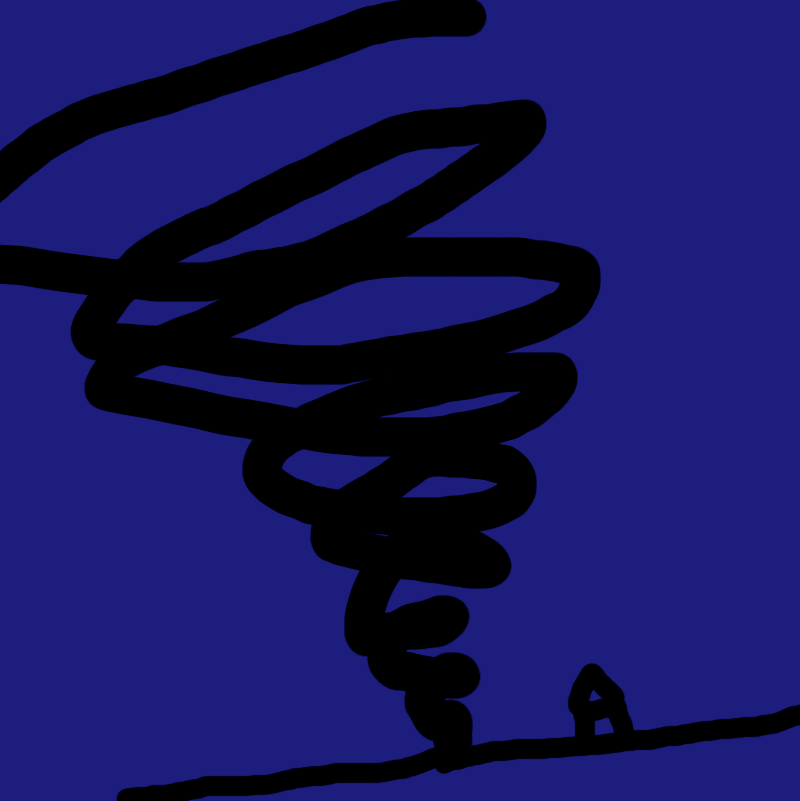
Wind currents
What makes wind?
The bigger the difference between high and low pressure the faster the wind goes. High pressure always moves into low pressure creating a current of wind. The movement of air from high-pressure areas to low-pressure areas, driven by the pressure gradient force, is what creates wind patterns in the atmosphere.
Air naturally moves from regions of higher pressure to lower pressure to equalize the pressure imbalances. The greater the difference in pressure over a given distance, the stronger the gradient force, which in turn generates winds. This force is a key factor in setting up and influencing wind patterns around the world, playing a vital role in shaping our weather and climate.
What is high pressure?
High pressure refers to an area of air with a higher density of molecules, causing it to weigh more due to Earth's gravity pulling it downward. High-pressure systems typically bring about clear skies and calm weather, as the dense air restrains the formation of clouds and strong winds. These high-pressure areas are generally stable and dry, characterized by low wind speeds and cooler temperatures.
What is low pressure?
Low pressure refers to regions in the atmosphere where there's a lower concentration of air molecules, making these areas relatively lighter and causing them to rise higher in the sky. Low-pressure systems typically bring about stronger winds and moist warm temperatures. This atmospheric setup encourages the formation of clouds and precipitation. As the rising air cools, water vapor condenses to create clouds, and the moisture-laden air can lead to rain.
Pressure gradient force in a simple example?
Some areas of the sky have more air molecules huddled together (that's high pressure) while others have fewer molecules (that's low pressure). Just like at a real party, molecules like to spread out. So, air from the crowded high-pressure zone goes, 'Hey, it's too packed in here, let's head to the low-pressure spot where there's more space to dance!' And that's why air moves from high to low pressure, creating wind that we feel on the ground.
Why do we often have a clear sky at night?
The Sun's heat warms up the atmosphere. When the air is warmed, it becomes lighter and rises higher into the sky. This rising warm air leads to the formation of low-pressure areas (clouds, windy).
At night, after the Sun sets, the ground and the air near the surface begin to lose the heat they absorbed during the day. This cooling causes the air to become denser and heavier, leading to the formation of high-pressure systems (less windy, no clouds). Resulting in clear skies at night that allow us to view the stars.
The dans with ocean currents
Ocean currents, like underwater highways, move warm and cold waters around the globe. Now, when warm currents flow to the sea surface, they can warm up the air above them. This toasty air then rises, creating a sort of 'vacuum' effect that draws in cooler air from over the ocean. This movement sets up wind patterns. On the flip side, cool ocean currents have the opposite effect – they chill the air above, creating areas of high pressure. These high and low-pressure zones, in turn, give rise to winds that swirl and dance across the planet. So, think of ocean currents as choreographers of the atmospheric ballet, shaping the winds that dance across the land. Watch Video of NASA
Earth's rotation (Coriolis effect)
Because our planet is spinning, stuff that's moving in a straight line seems to curve a bit, thanks to the Coriolis effect. So, when air tries to go straight from high pressure to low pressure, it gets a little twist due to the Earth's spin. This twist makes winds swerve and turn instead of going in a straight path. In the Northern Hemisphere, winds veer to the right, and in the Southern Hemisphere, they veer to the left. This funky spin is why wind patterns get all wiggly around the world!
Friction with Earth surface
When wind flows, it rubs against the ground, trees, mountains, and all sorts of things. This rubbing is called friction. Friction slows down the wind, and it doesn't move as smoothly as it does higher up. So, this 'bumpy' interaction with the ground messes with the wind's direction and speed, adding a twist to the wind patterns we see. Friction with the Earth's surface is like a sneaky player, mixing things up a bit and giving wind patterns an extra layer of complexity..
What are the wind currents?
There are 5 main wind zones that circulate below the stratosphere
Polar-easterlies
These winds are dry and cold, and they blow from the polar high-pressure zones towards the subpolar low-pressure areas. They are stronger during winter due to the increased temperature contrast between the poles and lower latitudes.
Westerlies
The westerlies are prevailing winds that blow from west to east in the mid-latitudes. They are influenced by the Earth’s rotation and the Coriolis effect, which causes them to curve poleward.
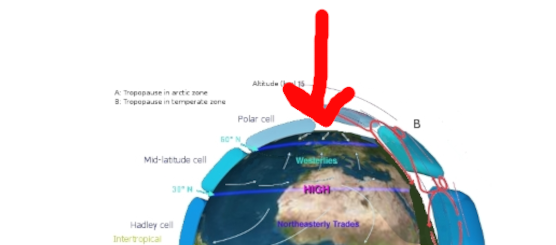
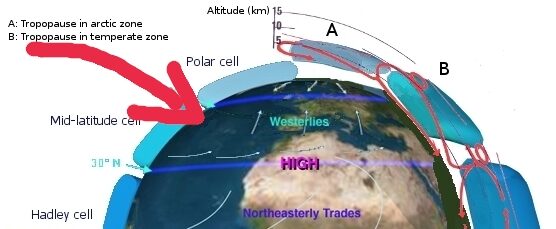
Trade Winds
Trade winds are consistent winds that blow from the subtropical high-pressure zones towards the equator. They are influenced by the Coriolis effect, which causes them to curve westward in the Northern Hemisphere and eastward in the Southern Hemisphere.
Horse Latitudes
The horse latitudes are located between the trade winds and the westerlies. They typically exist around 30 degrees latitude both in the Northern and Southern Hemispheres. These subtropical zones are known for their calm and variable winds. The name “horse latitudes” has a history tied to sailors who faced challenges during times of sluggish winds. To conserve supplies, they would sometimes throw horses overboard to lighten the load.
The Doldrums (ITCZ)
The doldrums, also known as the Intertropical Convergence Zone (ITCZ), is a low-pressure area near the equator where trade winds from both hemispheres meet. It’s characterized by calm and light variable winds, along with the potential for thunderstorms and heavy rainfall.
Jet Streams: These are powerful high-altitude air currents located near the stratosphere.
Polar Jet Streams
There are two polar jet streams, one circling Antarctica around the South Pole and another surrounding the Arctic Ocean, including Greenland, Alaska, and Siberia near the North Pole. The polar jet streams create the polar vortex and are crucial in steering weather systems at higher latitudes.
Subtropical Jet Streams
Situated between the equator and the polar jet streams, there are two subtropical jet streams. These high-altitude winds play a vital role in shaping weather patterns in the mid-latitudes, influencing the movement of storms and weather systems.
Arctic Polar Vortex
This phenomenon occurs at a higher layer in the stratosphere than the jet stream. It’s unique to Antarctica and forms exclusively during the winter season. The Arctic polar vortex is a bitterly cold wind current that moves in a spiral pattern. Notably, it hosts polar stratospheric clouds within, which contain ice crystals. These clouds play a significant role in ozone depletion and other atmospheric processes.
El Niño-Southern Oscillation (ENSO)
ENSO encapsulates the entire cycle of transitions between El Niño and La Niña, along with the durations spent in either phase. It’s the comprehensive package that defines the oscillating pattern.
The Tropical Pacific Ocean plays a significant role, stretching along the equator and allowing ample sunlight to warm its waters. This warm ocean environment serves as the backdrop for the El Niño-Southern Oscillation (ENSO) phenomenon. ENSO can bring about contrasting impacts, such as floods or droughts in places like Indonesia, Peru, and beyond. It influences temperatures over land, affecting them to be hotter or cooler than usual. The strength of the jet stream can vary, either becoming stronger or weaker due to ENSO’s influence. This phenomenon holds sway over ocean and wind currents, temperatures, and the well-being of marine life.
El Niño
This phase involves ocean warming along the coast of Peru, accompanied by low air pressure. Additionally, it triggers the upwelling of cold deep waters to the surface near Indonesia. This shift contributes to reduced rainfall in Indonesia, as high air pressure dominates the region. Wind currents tend to weaken during El Niño.
El Niño can lead to disruptions in global weather patterns, causing increased rainfall in some regions (such as flooding in South America) and droughts in others (like Australia and Indonesia). El Niño can also influence ocean currents, fish populations, and agricultural productivity, often with impacts on economies, ecosystems, and communities around the world.
The average duration of an El Niño event is typically around 9 to 12 months, but it can vary. It’s important to note that the timing, intensity, and duration of El Niño events are influenced by complex interactions between the ocean and the atmosphere, and they can be quite unpredictable.
La Niña
During this phase, cold deep waters rise to the surface along the coast of Peru. Conversely, warming waters have emerged in Indonesia. The outcome is increased rainfall above Indonesia and drought conditions in Peru. Wind currents, in contrast to El Niño, tend to strengthen.
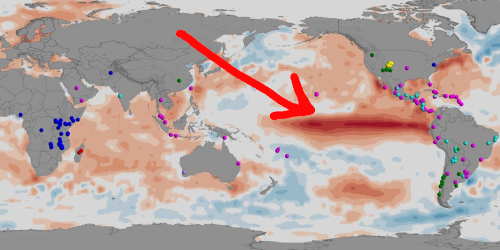
El Niño
NASA image
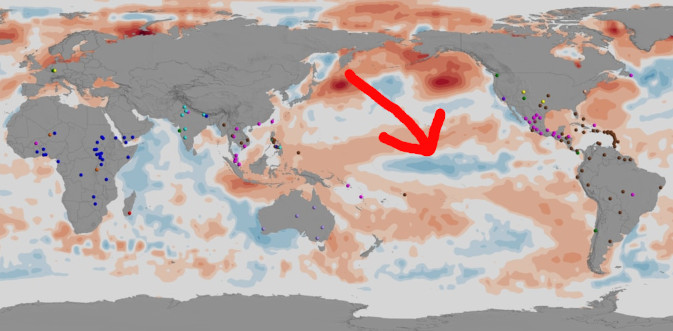
La Niña
NASA image
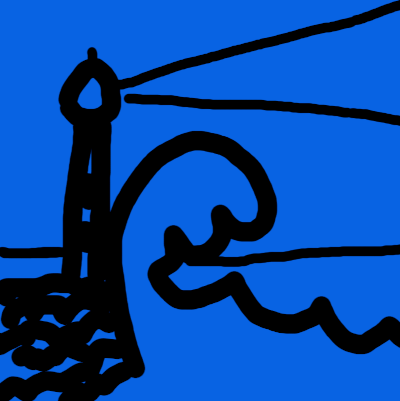
Ocean currents
Approximately 90% of marine life thrives within the sea’s uppermost layers, known as the sea surface, encompassing depths of 0 to 200 meters. This vital zone is illuminated by sunlight, nurturing photosynthesis, a process that generates oxygen through the activity of plankton, algae, and seaweed. However, it is also this sea surface that absorbs the most global warming and air pollution.
What makes ocean currents?
When it comes to ocean currents, we can broadly classify them into two categories: deep ocean currents, primarily driven by differences in density (coldness and saltiness at depth), and surface ocean currents, mainly influenced by winds. This dynamic interplay between wind-driven surface currents and density-driven deep currents orchestrates the complex circulation patterns within our oceans.
What are deep ocean currents?
Deep ocean currents, known as density-driven currents, are caused by differences in water density. Colder and saltier water is denser and tends to sink, while warmer and less salty water rises. This movement creates a slow and large-scale circulation of water deep within the ocean. These currents play a crucial role in distributing nutrients across the globe, influencing climate and marine ecosystems on a long-term scale.
Deep ocean currents sounds similar to wind currents?
In the atmosphere, differences in temperature create variations in air pressure. Warmer air rises, creating a low-pressure area, while cooler air sinks, generating a high-pressure area. Wind flows from high-pressure regions to low-pressure regions, creating the dynamic movement of air we observe as wind patterns.
Similarly, in the ocean, differences in water density due to temperature and salinity create variations in pressure. Cold and salty water is denser and sinks, leading to high-pressure zones, while warmer and less salty water rises, forming low-pressure areas. This density-driven movement of water drives the circulation of deep ocean currents.
What is so diffrent between them?
Wind currents in the atmosphere can travel at varying speeds, with jet streams, for example, reaching speeds of hundreds of kilometers per hour. These fast-moving wind currents play a significant role in shaping weather patterns and redistributing heat around the Earth.
On the other hand, deep ocean currents move at a much slower pace, often measured in centimeters or meters per second. While slow, they are crucial for the long-term circulation of temperature and nutrients throughout the oceans, influencing climate and marine ecosystems over extended periods.
What is upwelling?
Deep ocean currents, driven by differences in density due to temperature and salinity, are slower but have a significant impact on the overall oceanic circulation. They contribute to the vertical movement of water, transporting cold, nutrient-rich water from the depths to the surface in a process known as upwelling. This brings essential nutrients to the surface, supporting the growth of phytoplankton and marine ecosystems.
What are surface ocean currents?
Surface ocean currents are driven primarily by wind patterns at the ocean's surface. The wind's friction on the water's surface causes movement, generating currents that can extend to significant depths but are most noticeable near the surface. Surface ocean currents are more visible and have a more immediate impact on redistributing heat across the Earth's surface.
Why are surface ocean currents important?
They can transport warm water from the equator to higher latitudes and cold water from higher latitudes to the equator, influencing regional climates and weather patterns. These currents also help mix nutrients and oxygen near the surface, benefiting marine life.
These currents play a crucial role in distributing heat and nutrients across the ocean, impacting weather patterns and maritime navigation. They're essential for moving warm water from the equator toward the poles and cold water from the poles toward the equator, helping regulate Earth's climate.
How many oceans are their?
- Pacific Ocean
- Atlantic Ocean
- Indian Ocean
- Southern Ocean (also known as the Antarctic Ocean)
- Arctic Ocean
These oceans cover 70% of the Earth's surface and play a crucial role in regulating climate, supporting marine life, and influencing weather patterns. The division of the global ocean into distinct named oceans is largely a geographical and practical distinction, helping us navigate and study different regions of the world's waters. In reality, water moves between these oceans through various currents and oceanic processes, creating a complex and unified global ocean system.
What are the tides?
Tides are the regular rise and fall of sea levels caused by the gravitational pull of the Moon and the Sun on Earth's oceans. As the Moon orbits Earth, its gravitational force creates a "bulge" of water on the side of the Earth facing the Moon, leading to a high tide. On the opposite side of the Earth, there's another high tide due to the centrifugal force resulting from the Earth-Moon system's rotation.
Conversely, areas between these high-tide regions experience low tides. The Sun also contributes to tides, but its influence is less due to its greater distance. Tides occur twice daily as Earth rotates beneath these bulges, resulting in a regular pattern of high and low tides along coastlines.
What are sea spray areseols?
Aerosols released by waves are tiny airborne particles and droplets produced when ocean waves crash or break. These aerosols consist of water droplets, salt particles, and organic matter from the ocean's surface. These sea spray aerosols serve as the starting points for water vapor to condense into liquid droplets, which then come together to form clouds. (Cloud condensation nuclei)
Additionally, these aerosols can influence the reflectivity (both ultraviolet and infrared radiation back to space) of clouds, affecting the Earth's albedo and impacting regional weather patterns. Sea spray aerosols also contribute to the transport of nutrients and minerals from the ocean to land areas.
If sea spray aerosols contain harmful particles, such as pollutants or toxic substances, they can have negative effects on the air, land, and human health.
What makes surfing waves?
Wind blowing across the surface of the ocean generates friction. As the wind blows, it transfers its energy to the water, creating ripples and small waves. These small ripples interact and cause them to grow in size and become waves. The distance over which the wind blows is called the "fetch." A longer fetch allows waves to build up and become larger. Strong winds over a large fetch can create powerful waves. The energy from the wind moves through the water, causing the water particles to move in a circular motion beneath the surface. This concentration of energy causes the wave to rise and eventually break.
What are the major ocean currents?
There are countless ocean currents around the world, both major and minor, all contributing to the complex system of ocean circulation. It’s challenging to put an exact number on the currents due to their variability in size, strength, and regional influence. Major ocean currents are the most well-known and impactful ones, but there are many more smaller currents that also play crucial roles in the global oceanic circulation system.
Gulf Stream
Located in the North Atlantic Ocean, the Gulf Stream is a powerful warm ocean current that carries warm water from the tropics towards the North Atlantic. It has a significant impact on weather patterns in North America and Europe, helping to moderate their climates.
The Gulf Stream can move at speeds of around 2 to 4 knots (approximately 2.3 to 4.6 miles per hour) and can reach even higher speeds in some areas.
North Atlantic Drift
This is an extension of the Gulf Stream that flows across the northern Atlantic Ocean, continuing the transport of warm water towards Europe. It plays a crucial role in maintaining milder climates in western Europe.
California Current
California current flows along the west coast of North America. This cold-water current contrasts with the prevailing warmer currents in the region, creating an impact on the local marine ecosystem. It promotes the upwelling of nutrient-rich waters from the deep ocean, leading to high biological productivity and supporting diverse marine life, including marine mammals and fisheries.
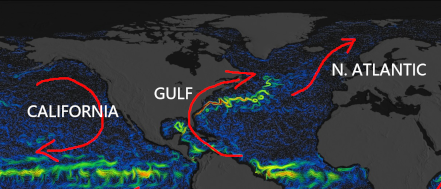
The Peru Current
Also known as the Humboldt Current. Just like the California Current, the Peru Current is a cold-water current that flows northward along the west coast of South America. It, too, encourages nutrient-rich upwelling from the deep ocean, supporting a productive marine ecosystem and influencing local weather patterns. These currents on opposite sides of their respective continents play vital roles in their regions’ oceanic and ecological dynamics.
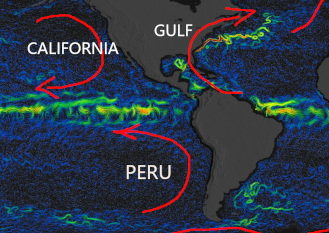
East Australian Current
This current transports warm water along the eastern coast of Australia, influencing the country’s climate and marine life. Both the Australian Current and the Kuroshio Current are warm ocean currents that transport warm water northward along the eastern coasts of their respective continents. The Kuroshio Current is generally stronger and has a more pronounced impact due to its proximity to powerful atmospheric systems, like the North Pacific Subtropical High.
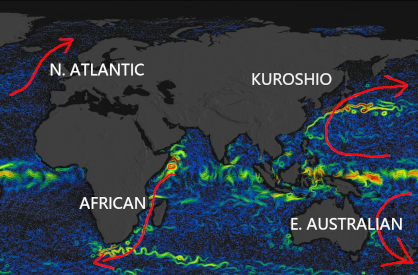
Kuroshio Current
This current flows along the east coast of Japan and is the Pacific Ocean’s equivalent of the Gulf Stream. Kuroshio Current and the Gulf Stream share certain similarities in terms of their functions and roles in their respective oceans, even though they are located in different parts of the world. Both are warm ocean currents that transport heat from the tropics toward higher latitudes. They play comparable roles in influencing the climates of the regions they flow through. The Gulf Stream influences the climate of North America and Western Europe, while the Kuroshio Current affects Japan’s climate.

The African Current
Also known as the South Equatorial Current, is a significant eastward-flowing surface current in the South Atlantic Ocean, located near the equator. This current is driven by the trade winds and the Earth’s rotation. While it transports warm water, it’s not as well-defined or powerful as the Gulf Stream or the Kuroshio Current. It covers a relatively smaller area compared to the expansive Gulf Stream and Kuroshio Current. It influences weather patterns, marine ecosystems, and the distribution of heat and nutrients in the region.
Antarctic Circumpolar Current (ACC)
The Antarctic Circumpolar Current (ACC) is one of the most significant ocean currents in the world. The Antarctic Circumpolar Current is the only current that flows completely around the Earth, encircling Antarctica. This makes it a crucial component of the global ocean circulation system. It helps connect the Atlantic, Indian, and Pacific Oceans, allowing the exchange of heat, nutrients, and marine life on a global scale. The ACC is a significant player in regulating the world’s climate. It transports vast amounts of cold water northward, affecting the distribution of heat around the globe.
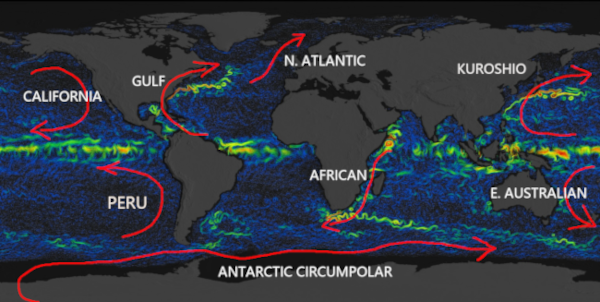
Ocean Conveyor Belt
This term refers to the overall system of interconnected ocean currents that circulate heat and regulate climate on a global scale. It includes various ocean currents in different oceans and their interactions. The term is often used as a metaphor to explain how heat is transported around the world’s oceans.
Atlantic Meridional Overturning Circulation (AMOC)
The AMOC is a specific part of the ocean conveyor belt system, operating within the Atlantic Ocean. It involves the movement of warm surface waters from the tropics to the North Atlantic, where they cool and sink to deeper layers of the ocean. This sinking process drives a slow and deep southward current, which is a crucial part of the global thermohaline circulation.
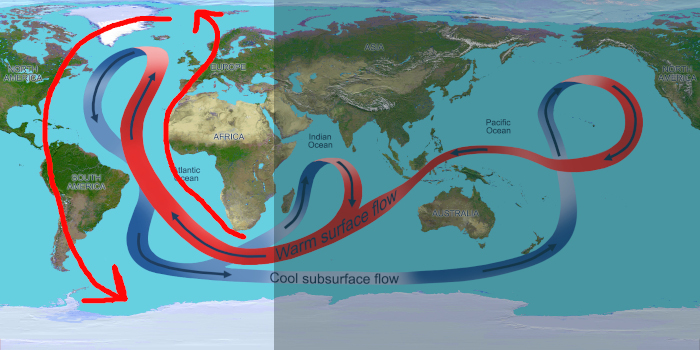
Potential danger
- Less water that is safe to drink
- Risk for the extinction of marine life
- Risk of ocean current shifts
- Risk of wind current shifts
- Extreme weather events
- Health hazard from Blue-green-algae
- Increase in water vapor
- Increase in Co2 and methane
- Thinning of the ozone layer
- Warming of the planet
- Turning oceans from mediators into accelerators for climate change
Solutions
The key solution is to end the overproduction of CO2 by reducing fossil fuel usage and protecting vital natural resources such as forests, peat bogs, and water. It's important that policymakers recognize the need for global cooperation to address this issue.
Policymakers hold the responsibility to safeguard our drinking water reservoirs and ensure the availability of clean water. It is essential to impose a ban on water sources being subject to stock market trading, preventing water from becoming a speculative investment.
It's imperative that we view our oceans with the same reverence as our land. Just as we've made commitments to safeguard 30% of our land, we must extend this commitment to our invaluable rivers and oceans.
Sources and credits
Changing Currents
Extreme Weather Connections
Do you know why changing currents contribute to extreme weather events? Can you shed light on these relationships and help us better understand them?

